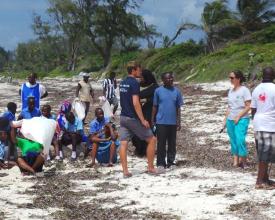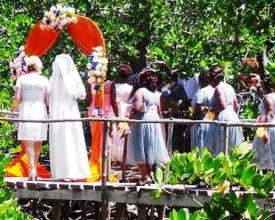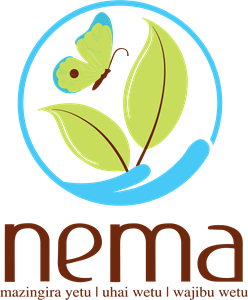
Example of successful symbiotic relationship between humans and the environment: Beneficial interaction of mangroves, Dabaso creek and the local community

The shores of Mida Creek lies around 100 kilometers north of Mombasa (Kenya) and adjacent to the Arabuko Sokoke Forest. Mida consists of marine and coastal ecosystems that comprise coral reefs, seagrass beds and mangrove forests, which are crucial for the livelihoods of the local coastal community. Coral reefs provide food and income to the communities and other goods and services of strategic importance to the economy including, tourism, fisheries, and coastal protection.
In 2014-2016, the Dabaso Creek Conservation Group (DCCG) received a grant by the community development program Hazina ya Maendeleo ya Pwani (HMP) under the World Bank. The funds were used for construction of a resource center, expansion of the kitchen/restaurant area and extension of the boardwalk. DCCG is a community based organization located in Watamu area at the Village of Dabaso.
Contexte
Challenges addressed
- Mangroves have been used by the community around Dabaso from time immemorial for construction material, firewood, medicine, and many other purposes. Convincing the community to prevent the cutting of mangroves in order to reduce shoreline erosion and other detrimental effects on the environment was a challenge.
- Dumping of plastic containers, food remains from the restaurant and waste materials after maintenance work posed great threat to the environment.
- Location of lavatories in the middle of the mangrove forest was a challenge. DCCG addressed this by constructing toilet facilities on the mainland away from the mangroves.
- Occasional scarcity of seeds (propagules) for planting new mangroves.
- Food would get finished due to overwhealmingly high number of guests arriving from nearby hotels without prior arrangement.
Emplacement
Traiter
Summary of the process
All the building blocks interact in parallel.
DCCG has benefited immensely from collaboration with national government agencies as well as local and international NGOs. The Kenya Marine and Fisheries Research Institute (KMFRI) offers technical advice on fabrication of suitable crab cages, training on appropriate method of replanting mangroves, collaborate in seeking development grants from regional and global partners, providing scientific field guides for translation into local language etc.
Kenya Wildlife Service (KWS) protects mangroves against indiscriminate destruction by developers and construction workers, boat users, fishers etc. guards mangroves from misuse by wood-loggers visitors and even the local people.
Students from elementary schools, colleges and universities all over Kenya visit Dabaso every month for study trips and excursions. They get to learn about mangroves, their cultural values and usage through lectures from members of DCCG and the local people. Under the guidance of DCCG, the local community participates in environmental protection activities such as beach clean-ups and planting of not only mangroves but also indigenous terrestrial trees that grow along the coastal zone.
Building Blocks
Training programs for the environmental conservation
Training DGGC members and the local community on environmental conservation is for the purpose of empowering the people to protect and conserve the environment for prosperity and sustainable use. Training is offered by Kenya Marine and Fisheries Research Institute (KMFRI), World Wildlife Fund (WWF), Kenya Forest Service (KFS) and various NGOs. The training has resulted in:
- Restoration of various mangroves species through reforestation programmes
- Stopping illegal methods of fishing, including use of poison and nets of small mesh size
- Reduction of fishing pressure from Mida Creek
- Sustaining Malindi-Watamu World Biosphere Reserve as part of the Marine Protected Areas of the Kenya coast.
Enabling factors
Majority of the community members have accepted the training programs. The community is now collaborating with trainers to create environmental awareness, which is a very important element to achieve the objective of this project.
Lesson learned
Visits by students from school, universities and colleges, tour guides on boat rides and bird watching trips have been great ways to help raise awareness about environmental issues.
Using the local Kiswahili language to explain to the community has yield in the faster results.
Involvement of local community, future plans sustainability
For sustainability of DCCG and long term community benefit, the group has focalised in the following actions:
- Construct eco-friendly accommodation facilities on their land adjacent to the creek.
- Introduce environmental friendly means of transport for ease of access to the restaurant and board-walk.
- Introduce computer learning centre in order to build capacity of the youth.
- Explore new ideas to increase jobs opportunities to the community;
- Extend beach clean-up to cleaning the street of Watamu.
- Contribute to the education bursary kitty to educate students in the local schools.
Enabling factors
- Partnership with the national Government, KMFRI, KWS, KFS in managing the mangrove forests.
- Collaboration with local and international NGOs such as WWF, KWETU and National projects e.g. KCDP, KEMFSED all have created strong linkages for sustainability.
Lesson learned
Generating partnerships allows to achieve the objectives in a more solid and efficient way and creating strong linkages for sustainability.
Crab Shark Restaurant expansion
Crab Shack Restaurant has become the icon of DCCG. It is reknown for its iconic samosa pastry deliciously made from crabs harvested in locally fabricated traps.
Expansion of the restaurant through funds obtained from KCDP under HMP has lead to:
- Attract more visitors for celebration, events.
- Job opportunity for the local communities especially the youth.
- Crab Shark restaurant attracts tourists from the nearby hotels to come and experience the unique atmosphere in the mangroves, crabs are reared in cages in the streams within the mangroves
Enabling factors
- Assured support from Kilifi County Government.
- More visitors both local and foreign.
- Job opportunity to the local communities especially the youth.
- Increased canoe rides to experience sundowner and bird-watching.
Lesson learned
The fact that DCCG have made agreements with the management of tourist hotels located in Watamu area and Malindi town has allowed to place the Crab-Shark restaurant in the tourists visit itinerary, giving in this way greater notoriety to the mangrove through its restaurant. Working together with other businesses in the area generates efficient alliances to make the project successful.
Impacts
- Agreements with the management of tourist hotels located in Watamu area and Malindi town to place the Crab-Shark restaurant in the tourists visit itinerary.
- Contribution to the development of schools and other community amenities around Dabaso and Watamu such as dispensaries. Schools are allocated special days to visit the DCCG and learn more about the importance of mangrove, crab cage farming and conservation and protection of the coastal environment.
- Youth are gaining practical experience and knowledge in coastal environment protection and conservation. DCCG members are invited to visit similar areas in Malindi, Kilifi, Mombasa and Kwale to teach fellow youths how to empower themselves and earn a living though a similar approach.
Beneficiaries
- Individual community members.
- Members of cultural groups, through performing traditional dances to entertain the guests.
- Schools in the neighbourhood have regular access to the DCCG training centre.
- Canoe owners make an income ferrying tourists to the mangroves.
Sustainable Development Goals
Story

Protecting the marine life of Dabaso and Mida Creek by living amidst the mangroves
Part of the success story about DCCG began in the late 1990s when researchers from Firenze University (Italy) led by Prof. Marco Vannini and Prof. Giuseppe Messana visited the Kenya coast. They established a collaborative research with the Kenya Marine and Fisheries Research Institute (KMFRI) under the guidance of Dr. Renison Ruwa and three young upcoming researchers, namely James Mwaluma, Diana Anyona and Melckzedeck Osore. The team identified Dabaso as a suitable area for research on crabs and infestations of isopods on mangrove roots. The researchers used to camp at Watamu and work day and night studying the migration of crabs and their interaction with mangroves. The local youths, some of them young employees of the tourists hotels in Watamu, used to assist by guiding the researchers in the mangrove forest and intertidal zones while identifying various crabs species and observing their behaviour. The results yielded much knowledge, which was later published in various scientific journals and also presented as Masters and PhD theses for a number of Kenyan and Italian researchers.
Benjamin Karisa, one of DCCG leaders recalls, “As a small boy in the early 1990s, I used to watch in amazement as researchers from Belgium, Italy and KMFRI spent a lot of time observing the movement of crabs in the sand and mangroves for many weeks. Their attempt to speak to us children in broken Kiswahili used to amuse me very much. I didn’t realize that I was subconsciously learning and understanding how the crabs and mangroves interact and I would one day become an expert”.
The local community recognized the importance of Dabaso and the wider Mida Creek as a possible stop-over location for researchers and established a small pontoon in the intertidal zone where they would camp and assist the scientists. Thereafter, the board walk was linked to the first restaurant constructed in the middle of the mangrove trees. The facility built by DCCG has become very popular for hosting social functions such as weddings, giving lecture to students, a preferred meeting venue for government institutions and NGOs, entry point of boat riding for tourists and a spectacular scenery for bird watching as well as for enjoying a drink or a meal of crab-samosa and other coastal delicacies as they observe the sun setting into the Indian Ocean.



















